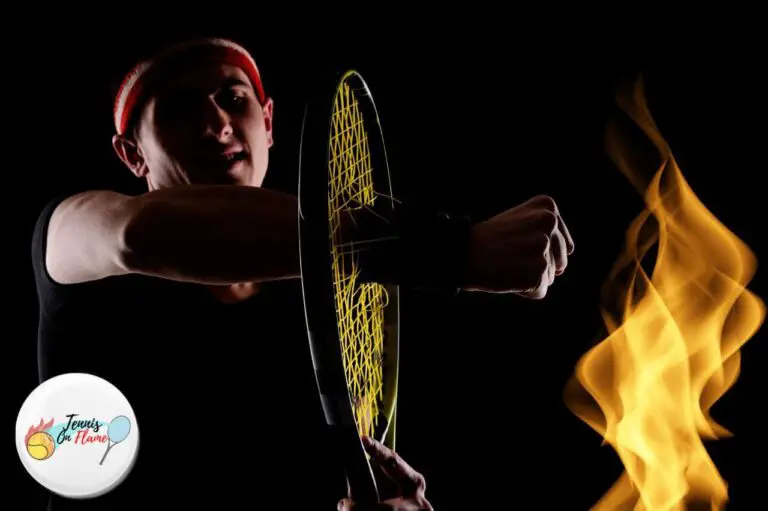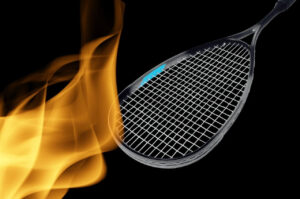A tennis racket is an important piece of equipment for any player – That’s why many players ask themself “Do tennis rackets go bad?”
Well, it’s important to take care of your racket and make sure it lasts as long as possible.
After all, you don’t want to have to buy a brand new racket all the time because they can be expensive.
Some people believe that tennis rackets go bad after three years, but this is not necessarily true. Some players use the same racket for five or even ten years without any problems.
In this article, we will discuss why tennis rackets go bad and how you can make them last longer.
We’ll also provide some tips on taking care of your racket so you can keep playing your best game!
Do Tennis Rackets Go Bad & Wear Out?
The answer to this question is yes, tennis rackets do go bad. But why do they go bad in the first place?
There are a few reasons why tennis rackets can start to deteriorate over time.
The main reason is that the strings on the racket will wear out.
As you play, the strings will become frayed and worn out which makes them less effective at hitting balls.
Another reason is that the frame of your racket can start to break down over time if it’s not taken care of properly or stored correctly when not in use!

How Long do Tennis Rackets Last?
So, how long do tennis rackets last before they start to go bad?
This depends on a few factors, including how often you play and what type of string you have on your racket.
Generally speaking, most tennis rackets will last between five and nine years for players who don’t play tennis In their daily routine.
For example, a player might only use their racket once per week or less during the winter months when there’s no outdoor tennis available.
But if we are talking about pro players and players who play all the time, they might only last for a year or two because of the constant use and abuse.
How Can You Make Your Tennis Racket Last Longer?
You can make your tennis racket last longer by taking care of it and making sure that you store it correctly when not in use.
Here are some easy ways to do that:
-Store your racket in a cool, dry place away from direct sunlight.
If possible, try not to leave it outside for long periods because this can cause the strings on your racket to deteriorate faster than they normally would (and also makes them more likely to break due to exposure to weather conditions).
-Keep your racket’s strings stretched and tight.
If you don’t do this, then they will become loose which makes them less effective at hitting balls (and more likely to break).
-Make sure that when you’re not using it regularly, keep the protective cover on so nothing gets inside and damages them like dirt or dust particles.
-Don’t use any harsh chemicals to clean your racket because they could damage the strings on it (and make them less effective at hitting balls).
You should only use water when cleaning your tennis equipment. You can also buy some special cleaners from stores that sell sports equipment if you want something more specific.
How to Take Care of Your Tennis Racket?
Here are some tips on how you can take care of your tennis racket and make sure it lasts as long as possible:
-Always use a good quality string when restringing your racket.
This will ensure that the strings don’t wear out as quickly and last longer.
-When not in use, store your racket in a safe place where it will be protected from any damage.
This might mean buying a special storage case or just making sure that it’s always put away in a dry and cool place.
-If you’re not going to be using your tennis racket for an extended period, take the strings off and store them separately.
This will help to prevent any damage from happening to them while they’re not in use.
-If you do see any damage on your racket (like a broken frame), don’t try to fix it yourself!
Take it to a professional who can help assess the extent of damage and determine whether or not it’s worth getting repaired.
How often should you replace your tennis racket?
As we mentioned earlier, how often you should replace your tennis racket depends on how often you play.
But as a general rule of thumb, most players should replace their racket every two to five years (or more if they are playing at a high level).
If you take good care of it and store it properly, then it should last even longer than that!
When it comes to tennis rackets, there are a lot of factors that can affect their longevity.
From how often you play and what type of string you have on your racket to how they’re stored when not in use, everything matters when trying to determine just how long they’ll last.
As such, it’s important to take good care of your tennis equipment so that you can get the most out of them and make sure they’re always ready when called upon!
Are old tennis rackets still good for playing?
It depends on how old your tennis racket is and how often you play.
Generally speaking, most rackets have a lifespan of two to five years (or more if you’re playing at a high level).
So if your racket is older than that or you don’t play as often, it might not be as effective as a newer one.
However, if it’s in good condition and you’re still hitting the ball well with it, there’s no real reason to replace it!
Just make sure that you take care of it properly so that it lasts as long as possible.
How long do tennis strings last?
The longevity of tennis strings depends on a variety of factors, including the string’s gauge (thickness) and construction material.
For example, most players will use either natural gut or synthetic gut as their main string type because these materials offer good durability without sacrificing too much power or feel when hitting shots.
However, some advanced players prefer polyester strings for their longevity and durability over time.
As such, it’s important to choose a string type that works best with your game style so you can get the most out of them!
But to answer the question – usually, players re-stringing their tennis racket’s strings every three to six months or so.
Do tennis racquets break?
Yes, they can break. Generally, it’s because of poor storage or misuse (too much pressure on one part).
If it does break, take it to a professional to assess the damage. They may be able to fix it or recommend a new racket. If not, purchase a new one!
How do I know if my tennis racket is broken and not good anymore?
If you notice any cracks on the frame of your racket or if it’s not hitting well anymore, then it might be time to replace it.
But before doing that, make sure that everything is set up correctly with string tension and grip size so there aren’t other issues at hand!
What are some signs that my tennis racquet is going bad?
There are many signs that your tennis racquet might be going bad. Some include: cracks on the frame, loss of power, cannot to hold a grip anymore.
If you see any of these signs, it is time to replace your tennis racquet.
How should I store my tennis racket?
When not in use, it’s important to store your tennis racket in a safe and dry place.
A good way to do this is by using a tennis racquet cover or bag.
This will help protect it from the elements and keep it in good condition for longer!
Do tennis rackets break easily?
Yes, they can.
But this is usually because of improper storage or misuse (too much pressure on one part)-
Not to mention the pro players who sometimes break their racket after a match out of anger –
Do you remember when Serena Williams broke her racket in the US Open after her fight with umpire Carlos Ramos?
But anyway, If it does break, take it to a professional to assess the damage and see if it can be fixed. If not, purchase a new one!
In conclusion
Tennis rackets do have a lifespan and can go bad after some time.
However, by taking proper care of your equipment and following the tips mentioned above you’ll be able to ensure that they last as long as possible!
And if not – just remember: there’s no shame in buying new ones now and then. that is what all the great tennis players do!
Just make sure to take care of your tennis racket so that it lasts as long as possible:
By following these simple tips in our guide, you can ensure that you get the most out of your equipment and don’t have to worry about replacing it anytime soon.
Have fun playing tennis! 🙂








